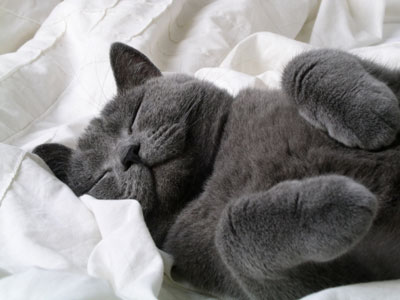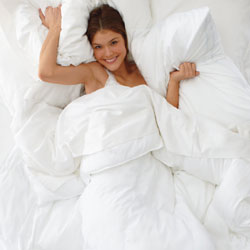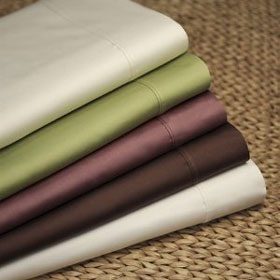THE STORY ON THREAD COUNT



High thread counts can certainly make for better sheets, but it's the thread that matters most. In fact, a sheet of a better-quality fiber with a lower thread count will feel softer and stand up to washing better than a sheet of a lower-quality fiber with a higher thread count. Besides thread count, here's what you pay for when you're buying sheets.
Fiber
Cotton-polyester blend sheets are wrinkle-resistant, durable (polyester lasts longer than cotton), and relatively inexpensive (up to half the cost of all-cotton). But if you're looking for that cool, soft feel, nothing beats 100 percent cotton. You'll hardly ever wake up clammy on cotton sheets, since the fiber wicks moisture away from your skin. And cotton sheets are less likely to stain than polyester blends; a water-loving fiber, cotton releases dirt easily when wet.
All types of cotton share these wonderful traits, but long-staple (or long-fiber) cotton makes for a noticeably softer sheet, and the surface won't pill and lint like one woven from shorter fibers. The words "Egyptian long-staple," "pima," and "Supima" all denote high-quality long fibers.
Weave
The weave affects the way a sheet feels, the way it looks, its longevity, and its price. Basic plain weaves, which are woven from an equal number of vertical and horizontal yarns, are least expensive and may not rate a mention on the label. Percale is an upscale plain weave with a thread count of 180 or higher and is known for its longevity and crisp feel.
Sateen weaves have more vertical than horizontal yarns. The higher proportion of vertical threads results in an extremely soft fabric, but one that is more apt to pill and tear than a plain weave. Intricate weaves, such as jacquards and damasks feel textured, with a pattern alternating from satiny soft to coarser and nubby. They can be as durable as plain weaves, but they are made on special looms and are considerably more expensive.
Finish
Most sheets are treated with chemicals (including chlorine, formaldehyde, and silicon) to keep them from shrinking, losing their shape, and wrinkling. Some are treated with alkalis to produce a sheen.
A handful of manufacturers offer pure-finish sheets, meaning that no chemicals were used or that all traces of chemicals used during manufacturing have been removed. You'll have a harder time keeping these sheets wrinkle-free, but it may be worth it if you suffer from allergies or chemical sensitivities. Another finish-free option: organic sheets, which are untreated and woven from cotton grown without the use of pesticides.
Dye
Patterns and colors are usually applied to sheets after they're woven, which means the sheets may feel stiff until you've washed them a few times. The softest (and most expensive) colored or patterned sheets, including jacquard weaves, are made of yarn-dyed fabrics, woven from colored yarns.
